Greek Island Hopping 2022: Complete Guide
Sandy beaches lapped by crystal-clear waters, buzzing nightlife, ancient ruins and fragrant olive groves - these are just some of the attractions found on Greece’s many islands.
It would take a lifetime to explore them all, but in this guide we’ll highlight some of the very best - whether you’re in search of secluded beaches, history, hedonistic partying - or a little of each.
What is Greek island hopping?
Greek island hopping is the process of sailing between different Greek islands for tourism purposes.
The term 'hopping' is perhaps a slight misnomer since it makes it sound rather quicker and easier than it actually is. Indeed, you may only have time to 'hop' between a handful of islands during your trip - unless you wish to spend most of your time at sea!
Choosing which Greek islands to visit
Greece is blessed with between 1,200 and 6,000 islands - although only 227 of these are inhabited. Nevertheless - for a visitor, that's a lot of islands to choose from.
And if you've only got a couple of weeks to spare, you'll need to choose your islands wisely.
What are the main island groups of Greece?
There are six Greek island groups to consider:
- The Cyclades
- The Ionian Islands
- The Sporades
- The Dodecanese
- The Saronic Islands
- The North Aegean Islands
Additionally, there are the two largest Greek islands, Crete and Evia. If you only have a week or two in Greece, you may wish to focus on one of these island groups.
When is the best time to visit the Greek islands?
For swimming, tanning and beach-going, late May to early October are the best months. For hiking and sightseeing, April to November.
Being a Greek island hopper in winter is more of a challenge since services are more likely to be cancelled if weather is bad.
What is the purpose of island hopping?
Island hopping is simply a great way of exploring multiple islands during your holiday.
It’s arguably not suitable for those who prefer to lounge by their hotel pool for two weeks!

What ferries and catamarans are there in Greece?
Greece has a very well developed ferry and catamaran network.
Ferries can be large - with up to eight floors of restaurants, bars, cafes and seating of various classes. Reserved seating tends to be more comfortable with better views. Most big ferries have sun decks which are great for enjoying views across the vast Aegean Sea.
Larger ferries offer sleeping cabins - ideal for longer overnight routes (e.g. Athens to Crete).
Catamarans usually have two floors and travel much faster than ferries - but the downside is they offer a much bumpier ride.
Note that ferry and catamaran schedules may not be as regular as before the pandemic.
Where can I buy ferry or catamaran tickets for my Greek holidays?
You can buy tickets in advance online, or at travel agencies across Greece.
Two of the main online ticket portals for Greek ferry tickets are:
- https://www.ferryhopper.com/
- https://ferries.greeka.com/
Which is better - Greek Island tours or Greek Island packages?
For ease and simplicity, you may decide to book a complete Greek island tour - where all your travel (ferries/catamarans), transfers accommodation are arranged by a travel agency in one package.
However, you may find it cheaper and less restrictive to book ferries and accommodation yourself. This gives you the freedom to stay on an island longer (or leave earlier) if you wish.
Unless you're unused to booking hotels and transport online, a self-organised tour package may not be the best option.
Quick tips for Greek island hopping vacations
- Plan which of the Greek islands you will visit before you leave - and how long you will stay on each.
- Aim for at least 2-3 nights on each island, or you won’t have enough time to explore and relax. On some of the Greek islands you could easily spend 5-10 days.
- There's something for every budget when it comes to Greek island holidays. You can spend as much as 400 euros or as little as 30 euros a night - even on a popular island like Santorini. Search AirBnB and Booking for the best rates (and book early).
- Mobile phone reception is good on Greek islands - whether using a local SIM, or roaming with your own UK SIM.
- ATMs are found on most of the medium and large Greek islands. Some of Greece’s smaller islands may not have ATMs, so make sure you have enough cash to keep you going.
- Greek shop owners tend to take siestas around noon.
- If you're planning to hire a car in the high season months of July/August, make sure you book it well in advance.
- The ferries usually run on time, though can occasionally be late. And if you're late, your ferry will not wait for you!
- If you visit Greece in winter be prepared for ferries to be cancelled at short notice if the weather is bad.
- Make sure you take out comprehensive travel insurance before you leave the UK.
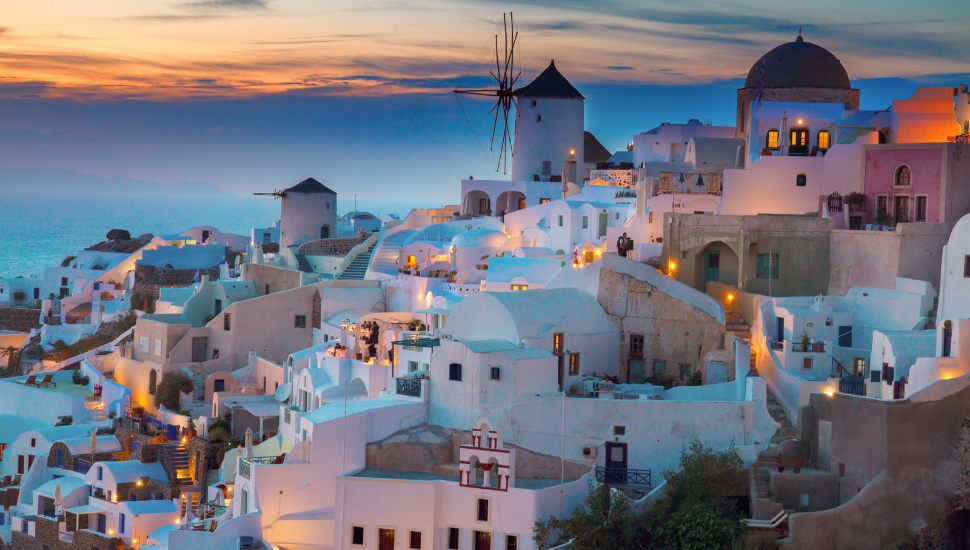
Cyclades Islands
Arguably the best known of all locations for Greek island hopping, the Cyclades is so named because they cluster in a roughly circular formation.
It comprises hundreds of islands, but the most famous are Santorini (Thera); Mykonos; Ios; and Naxos.
Santorini
The ethereal beauty of its white-washed villas, cascading down to a glittering blue sea have made Santorini the poster-child of Greek tourism.
And while it tops the list of many Greek island hoppers, it's no less appealing for being slightly over-visited.
How to reach Santorini
- Fly - into Santorini airport
- Ferry - from Athens (up to 8 hours)
How to get around Santorini?
Renting a car is almost essential in Santorini, unless you're prepared to brave the overcrowded public bus system!
Fira and Oia
The picturesque villages of Fira and Oia are considered must-visits while on Santorini.
Fira offers quaint cobbled alleyways, top-brand shops and views over the caldera.
You can walk by the sea to the villages of Firostefani and Imerovigli, and then on to Oia.
Aside from great restaurants and shops, Oia is best known for its Byzantine Castle ruins.
Mykonos
If you're looking to party, Mykonos will not disappoint; after all, this Greek island is well known among Britons for its effervescent nightclub scene.
But Mykonos is not all about foam parties and drinking games. It boasts some stunning beaches as well as luxury hotels, great shopping and fabulous seafood restaurants.
How to reach Mykonos
Most Mykonos-bound Brits fly into Mykonos airport (4 hours from London), although it can of course be reached by ferry (from Athens) as part of an island-hopping adventure.
How to get around Mykonos?
Unlike Santorini, renting a car is not necessary on Mykonos, thanks to its reliable and cheap public bus system. However, a hire car will give you a little more freedom to explore the island at your own pace.
Note: there are only about 30 taxis on Mykonos.
What are the best beaches on Mykonos?
Mykonos is fringed with many beautiful beaches, but two of the most family-friendly are Ornos Beach and Platis Gialos.

The Ionian Islands
The Ionian archipelago boasts some of Greece's most famous islands, including Kefalonia, Zakynthos, and Corfu - arguably the most popular vacation isle in the Ionian sea.
Kefalonia
Kefalonia is the largest of the Ionian islands and boasts the most dramatic mountains.
A regular ferry connects Kefalonia to Zakynthos.
Kefalonia is also home to some of Europe's finest beaches, including the stunning Myrtos beach.
Zakynthos
The world famous Shipwreck Beach remains the top attraction in Zakynthos - and with good reason. Steep chalky cliffs tower over the idyllic cove with the eponymous shipwreck, lapped by azure-blue Ionian waters.
The island is also edged by many more fabulous beaches - which are best explored by hiring your own boat.
There are also plenty of party boat trips - popular with younger British tourists.
Corfu
Probably the best known of the Ionian islands, Corfu has been dubbed the Emerald Island thanks to the colour of its waters.
As with so many tourist destinations, Corfu's popularity has been - to a degree - its undoing, since it is far more crowded than other islands in the Ionian archipelago.
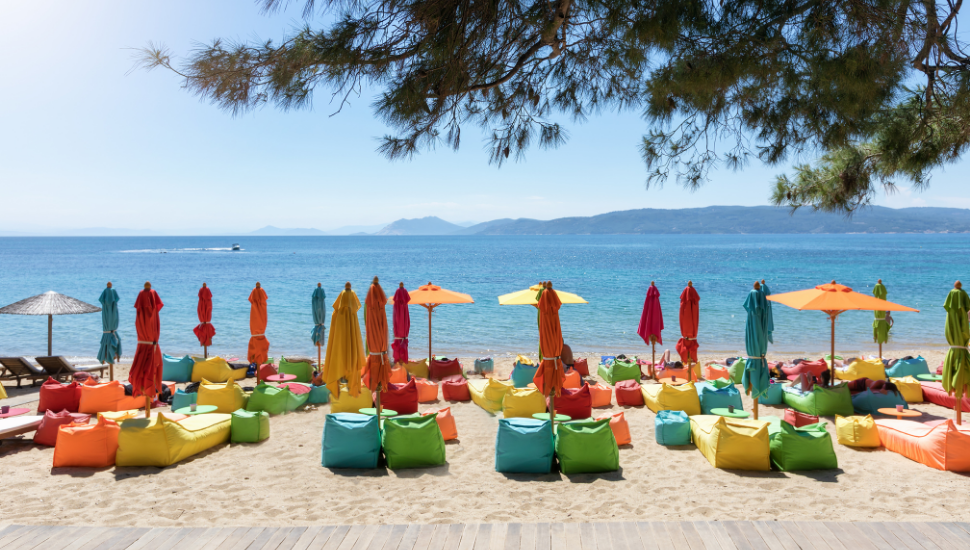
The Sporades
The Sporades are chiefly composed of four main islands - Skiathos, Skopelos, Alonissos and Skyros.
Skiathos
Popular with younger visitors, Skiathos has more than 60 wonderful beaches and a vibrant nightlife.
Greek island hoppers can of course reach Skiathos by ferry - but there is also an international airport.
Skopelos
Skopelos tends to be frequented by families and older travellers. It offers a more relaxed experience compared to Skiathos, blessed as it is with olive groves, pine forests and plum- and almond orchards.
Enjoy breathtaking sea views from Glossa and Skopelos Town.
Alonissos
The most serene of the Sporades, Alonissos is a verdant mountain of pines and olive trees.
Fragrant herbs grow wild, while alluring aqua-marine bays entice into her warm Aegean waters.
Skyros
Covered in rolling farmland and fringed with shimmering bays, Skyros is less-visited than its Sporades siblings.
What is there to do on Skyros?
Wellness courses are available at the UK-owned Skyros Centre, while nature lovers can spot Eleonora's falcon and the island's famed small-bodied wild horses (as ridden by Achilles, as legend has it).
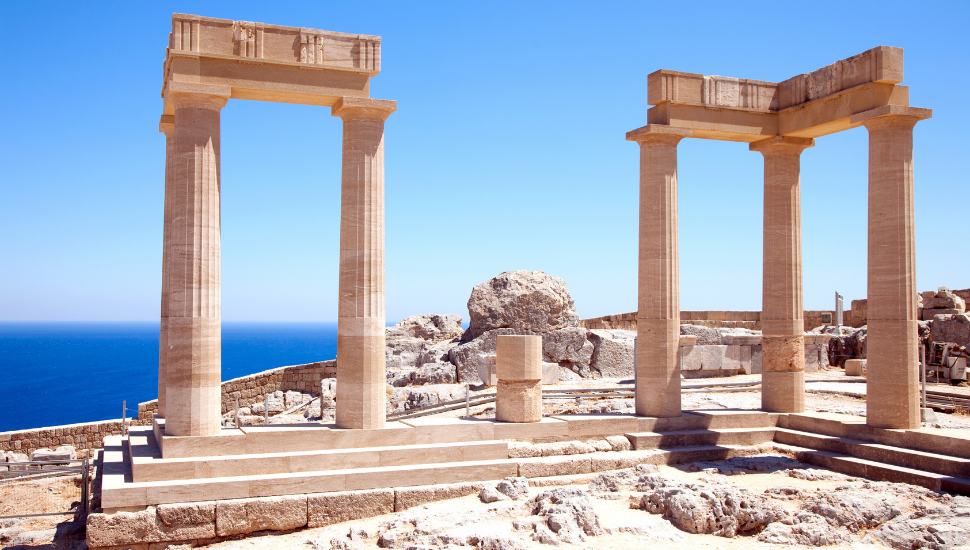
The Dodecanese
The far-flung Dodecanese invites you to experience a bygone Greece, where time has - more or less - stood still in many parts.
Here you'll see remnants from many empires, including Greek, Roman, Byzantine and Ottoman.
The Dodecanese comprises of 15 larger islands and more than 150 smaller ones, depending on the definition of 'island'.
Rhodes
By far the largest and most historically important island in the Dodecanese, Rhodes (Rodos) offers something for every taste, with a buzzing nightlife, laid back beaches, and scuba diving in clear gas-blue waters.
Rhodes can get a little crowded in summer, but it's big enough that you'll find your own little patch of calm on this unique island.
The Acropolis of Lindos and the Palace of the GrandMaster are among the historic highlights.
Kos
Edged by the most beautiful beaches in the archipelago and punctuated with lush green valleys, Kos is a truly alluring island.
You'll stumble across two-thousand year old Corinthian columns everywhere you go - to the extent they'll no longer astonish you by the time you leave - if you can pull yourself away.
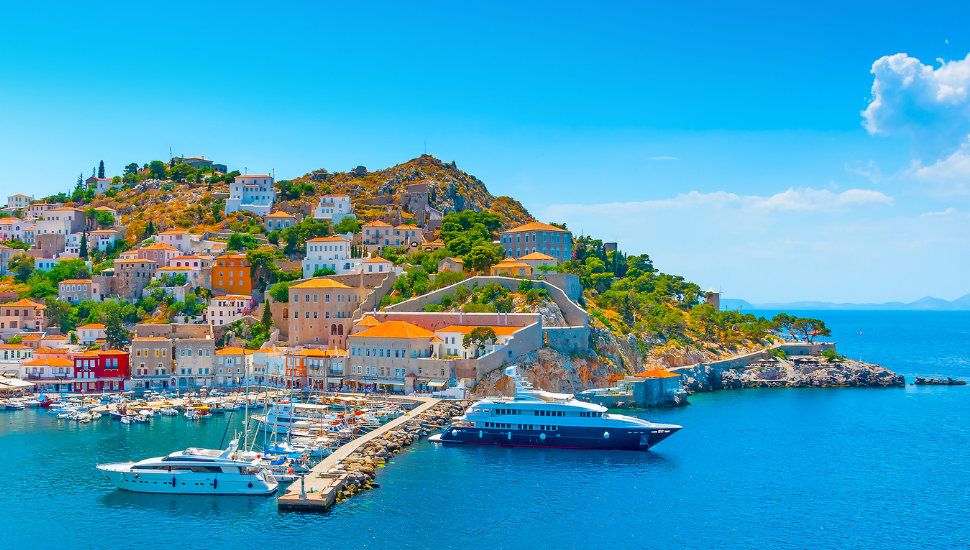
The Saronic Islands
For those flying into Athens, the Saronic Islands are the most conveniently located of all the Greek islands.
Despite its proximity to the big smoke, these islands feel a million miles away and each of the Saronic Islands offers its own character.
Hydra
With zero cars, Hydra is an extremely tranquil island; you'll need to get around on foot, by boat, or donkey.
With such old-school transportation modes, and some grade-A beaches, it's one of the most peaceful places to escape the noise and heat of the capital (2 hours by high speed ferry).
Spetses
Also just 2 hours from Athens, Spetses' coast is punctuated with elegant Venetian mansions, and is ideal for long strolls and lengthy dips in the crystal-clear waters.
Aegina
One of the most important islands in ancient Greece, Aegina boasts numerous fascinating ruins, including Athena Aphaia, dating back to the 6th century BC.
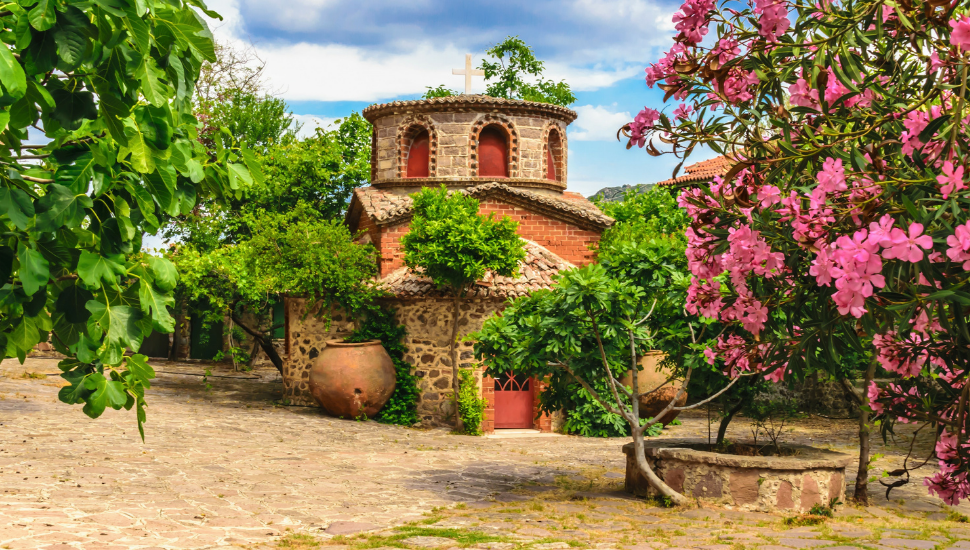
The North Aegean Islands
Each of these idiosyncratic islands has its own unique character, with histories stretching back as far as 5,000 BC.
The North Aegean Islands are not part of an island chain, but fall under the above title for tourism and administrative purposes.
Samos
Arguably the most popular of the North Aegean islands, Samos features forested hinterland mountains and many secluded, seldom-visited beaches.
Outside the vibrant capital Vathy, it's a rather low-key, chilled island.
Lesbos
Sandy beaches, salt marshes and desert-like plains typify Lesbos' (Lesvos) landscape. The island is also home to about 11 million olive trees.
The most picturesque town of Lesbos is Molyvos (aka Mithymna) with its old stone villas overlooking the sea.
Don't miss the island's therapeutic hot springs.
Thasos
Green and tranquil Thasos lies 10km from mainland Kavala.
Cheaper than most Greek islands, Thasos attracts families and students from Bulgaria.
Pretty sandy beaches and dense interior forests make this Greek island something of an undiscovered gem - at least in terms of UK visitors.
Its delights are easy to explore thanks to the well-run bus network.
Get a Quote